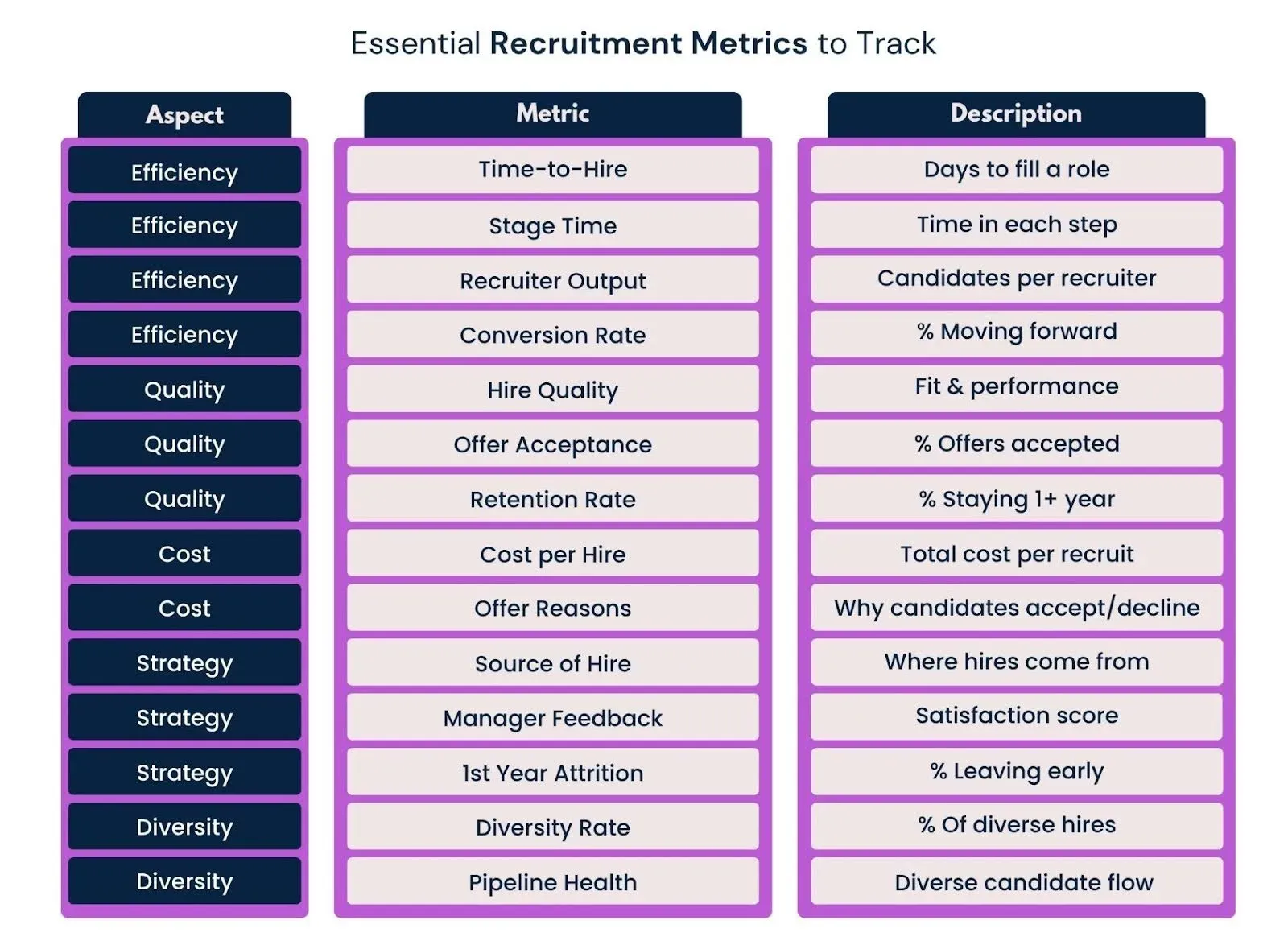
Finding and retaining top talent is more challenging than ever. According to a recent report, 67% of recruiters report that identifying candidates with the right skills is their top hiring challenge. This growing difficulty highlights the urgent need for organizations to refine and optimize their recruitment strategies. One of the most effective ways to achieve this is by tracking key recruitment metrics.
In this blog, we will explore 15 essential recruitment metrics that will help you improve your hiring strategy and stay competitive in today’s talent market.
Recruitment metrics are data points used to assess and analyze the effectiveness of the hiring process. These metrics provide measurable insights into various aspects of recruitment, from the time it takes to fill a position to the quality of the hires made. Through the collection and analysis of these metrics, HR teams can spot trends, refine recruitment strategies, and tackle inefficiencies as they occur.
Understanding what recruitment metrics are is just the first step. You need to know why they matter, which is where they truly become powerful. Now, let’s explore why tracking recruitment metrics is crucial for long-term success.
Recruiting the right talent is more than filling vacancies. Your recruitment strategy should be about making strategic, data-driven decisions that enhance workforce quality and efficiency. These are a few reasons to take notice of recruitment metrics:
A structured approach to tracking hiring data leads to smarter decisions, better hires, and a stronger workforce. Now, let’s take a closer look at these essential metrics and how they can drive better recruitment outcomes.

Suggested Watch: This video shows the recruitment metrics that are essential for optimizing the hiring process.
Recruitment is one of the most critical functions of any organization, as it directly impacts the talent pool that drives business success. Recruitment metrics offer HR teams a clear, measurable view of the entire hiring process, from sourcing candidates to onboarding new hires.
The following table presents 15 key recruitment metrics categorized into five distinct segments: Efficiency Metrics, Quality Metrics, Cost Metrics, Strategic Metrics, and Diversity Metrics.

Tracking the right metrics will enable you to make improvements on the fly and also help you align your recruitment efforts with organizational goals. These recruitment metrics are explained in greater detail in the following sections.
Suggested Read: Understanding the Concept of Total Rewards in HR
Efficiency metrics are crucial for evaluating the speed and efficiency with which candidates progress through the recruitment pipeline. These metrics help identify where improvements can be made to reduce delays, minimize bottlenecks, and make sure that recruitment resources are being optimized.
Time-to-hire measures the total time taken from when a job requisition is opened to when a candidate accepts the offer. It is one of the most important efficiency metrics, as it shows how quickly your team can fill open positions.
CompUp offers real-time insights on your recruitment timeline and can help you identify bottlenecks in the process. With Hireshot, you can further refine this process by creating an engaging and professional digital offer experience. Features like Offer Engagement and Intelligent Offer Assistant allow candidates to stay engaged throughout the hiring journey.
Time in stage tracks how long candidates spend in each stage of the recruitment process, from application to interview to offer acceptance. This allows you to identify stages where candidates are getting stuck or delayed.
Recruiter productivity tracks the number of candidates processed, interviews conducted, and offers extended by each recruiter. This metric helps gauge how effectively recruiters are managing their workload and the speed at which they move candidates through the hiring pipeline.
The candidate pipeline conversion rate measures the percentage of candidates who advance from one stage of the recruitment process to the next. For example, it can track the percentage of applicants who are selected for interviews or the number of interviewees who move on to receive job offers.
Now that we have covered efficiency metrics, let’s shift focus to quality metrics, which help measure the effectiveness of your hiring process in attracting and selecting the right candidates.
Suggested Read: Understanding the Basics of Developing a Competitive Pay Structure
Quality metrics allow HR teams to move beyond simple hiring speed and cost, and instead focus on the overall impact that recruitment decisions have on the company’s success.
Quality of hire measures the performance, productivity, and cultural fit of new hires. It’s typically assessed through performance evaluations, retention rates, and employee feedback, providing a comprehensive view of how well a candidate aligns with the company’s needs and values.
Offer acceptance rate tracks the percentage of job offers accepted by candidates, relative to the number of offers extended. It provides insights into how attractive your offers are to top talent and whether there are any issues that could lead to candidates declining your offers.
CompUp’s Compensation Benchmarking allows you to compare your hires' compensation packages against real-time market data. This helps you offer competitive salaries that attract top talent and aligns your compensation strategy with high performers.
Retention rate of new hires measures the percentage of new employees who stay with the company after a specific period, usually one year. This metric indicates whether the recruitment process is selecting candidates who are a good long-term fit for the organization.
Diversity hiring metrics track the diversity of applicants and hires based on factors such as gender, race, ethnicity, and other diversity indicators. These metrics provide insight into how effectively your recruitment process is attracting diverse candidates and building a more inclusive workforce.
Having explored quality metrics, let's now shift our focus to cost metrics.
Suggested Read: Understanding the Gender Pay Gap and Pay Disparity in the U.S.

From the Community: This Reddit thread talks about strategies and best practices for balancing sourcing with full life-cycle recruiting.
Cost metrics are essential for understanding the financial efficiency of the recruitment process. These metrics help HR teams balance the costs of hiring with the need to maintain high-quality recruitment, making sure that the recruitment budget is being utilized effectively without compromising on the quality of hires.
Cost per hire is a metric that calculates the total cost of hiring a new employee, including expenses such as advertising, agency fees, recruiter salaries, interview costs, background checks, and onboarding. It provides a clear picture of the financial investment required to bring in a new hire.
This metric tracks the reasons why candidates accept or decline job offers. A low acceptance rate or frequent declines due to similar reasons may highlight issues with your employer brand, compensation packages, or the attractiveness of the job itself.
With cost metrics in place, we now turn our attention to strategic metrics. These metrics provide valuable insights into how well your recruitment efforts align with your long-term organizational goals.
Suggested Read: Difference between Gross Pay and Net Salary: Definitions and Examples
Strategic metrics offer a broader, long-term perspective on recruitment, enabling organizations to align their hiring strategies with business objectives. These metrics are valuable for understanding how recruitment decisions impact overall organizational performance.
Source of hire tracks where your candidates are coming from. This can be through job boards, employee referrals, social media platforms, or recruiting agencies. This metric allows you to identify which sourcing channels provide the most successful candidates and which are underperforming.
Hiring manager satisfaction measures how satisfied hiring managers are with the recruitment process. This metric is typically gathered through surveys or feedback from hiring managers after each recruitment cycle and reflects their satisfaction with candidate quality, communication, and the overall process.
First-year attrition rate measures the percentage of new hires who leave the company within their first year of employment. It’s an indicator of how effectively the recruitment process identifies candidates who are a good fit for the role and the company culture.
Having covered strategic metrics, let's now focus on diversity metrics.
Diversity metrics are essential for promoting inclusivity in your recruitment process and attracting candidates from a wide range of backgrounds. Tracking diversity metrics helps organizations align with diversity, equity, and inclusion (DEI) goals to create a more diverse, innovative, and equitable workplace.
Diversity hiring metrics track the diversity of candidates in your recruitment pipeline, including demographic factors such as gender, ethnicity, race, age, and disability status. These metrics allow you to assess how effectively your recruitment process is attracting and hiring diverse talent.
Suggested Read: Defining DEIB: Understanding Diversity, Equity, Inclusion, and Belonging at Work
Candidate diversity pipeline health measures how well your recruitment process is attracting and advancing diverse candidates through the hiring stages. This metric provides a closer look at the diversity balance in your candidate pool at different stages of the recruitment process (e.g., applications, interviews, offers).

Recruitment strategies must include DEIB principles for diverse, inclusive, and fair hiring practices. To learn more about integrating pay equity and DEIB into your compensation strategy, check out the Compensation Insider Podcast.
Now, let’s explore how to capitalize these metrics to maximize hiring outcomes.
Employing recruitment metrics effectively can transform your hiring strategy, ensuring better talent acquisition while reducing inefficiencies. Here’s how to use them to refine and enhance your hiring process:
By actively measuring and analyzing these metrics, companies can refine their recruitment approach, cut inefficiencies, and build stronger teams. Now, it's time to take your strategy to the next level with CompUp.
Tracking recruitment metrics is just the beginning. However, making the most of them is where the real impact happens. With CompUp, you can upgrade your compensation management process with powerful, data-driven solutions that help you make smarter decisions faster.
These are a few ways CompUp can simplify the compensation and talent management process in your organization:
The right recruitment metrics can transform your hiring process and ensure compensation aligns with long-term success. CompUp tracks key data to attract top talent while ensuring your compensation packages are competitive, creating a stronger, more efficient recruitment pipeline.
Ready to take control of your recruitment metrics and build a high-performing team? Request a demo of CompUp today and start improving your recruitment process for the future!
Recruitment metrics are powerful tools that provide actionable insights into every aspect of the hiring process. By tracking key metrics, HR teams can optimize their strategies, enhance efficiency, and make informed decisions that align with broader organizational goals.
With the right data at your fingertips, you can simplify processes, reduce costs, and build a stronger, more capable workforce. With features like Compensation Benchmarking, Rewards Statements, and Hireshot, CompUp enables real-time tracking of key metrics. This helps drive recruitment success and ensures compensation strategies align with top talent needs.
Are you ready to reduce costs and improve efficiency in your hiring process? Get started with a free demo and transform your recruitment strategy.
1. What recruiting metrics to track?
Track key metrics like time-to-hire, cost per hire, quality of hire, candidate satisfaction, offer acceptance rate, source of hire, and diversity metrics to optimize recruitment processes and improve hiring outcomes.
2. What are KPIs for recruitment?
Key performance indicators (KPIs) for recruitment include time-to-hire, cost per hire, candidate quality, retention rate, offer acceptance rate, diversity hiring, and hiring manager satisfaction. These KPIs help assess recruitment effectiveness and guide improvements.
3. How to measure the effectiveness of recruitment?
Measure recruitment effectiveness by tracking metrics like time-to-hire, cost per hire, candidate quality, diversity, retention rates, and hiring manager satisfaction. Analyzing these KPIs reveals the efficiency, cost-effectiveness, and quality of your recruitment efforts.
4. How do you measure performance in recruitment?
Recruitment performance is measured using metrics such as recruiter productivity, time-to-hire, candidate quality, conversion rates, and offer acceptance rates. These metrics help evaluate how efficiently and effectively recruiters fill roles while maintaining quality and cost control.

Co-founder & Head of Product
Anshul Mishra, Co-founder and Head of Product at CompUp, blends technology and total rewards to create smart, user-friendly solutions. He focuses on building data-driven tools that help companies design fair and effective compensation strategies, making complex processes simpler and more impactful.
Revolutionizing Pay Strategies: Don't Miss Our Latest Blogs on Compensation Benchmarking